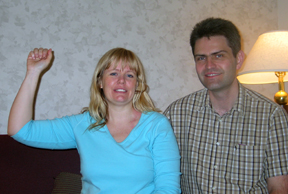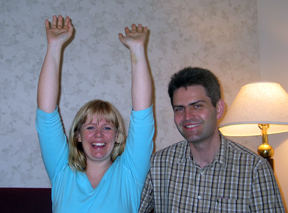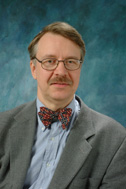 |
Above: Karin Andersson demonstrates how high she could raise her arm before the surgery. Below: After the surgery, Andersson is able to extend her arms — without pain — toward the sky. Andersson and her husband, Magnus, traveled from Gagnef, Sweden, to Omaha for the surgery. |
 |
Unlike traditional surgery, however, these patients are awake on the operating table and the success of the operation depends upon their ability to feel pain during surgery.
Some people may be squeamish about being conscious, but Ake Nystrom, M.D, Ph.D., says patient participation is vital to the success of the procedure. Pain, he said, is not a visible symptom and radiographic imaging or tests of nerve conduction don’t always give an adequate assessment of pain or its focal origin. So, Dr. Nystrom relies on the patient’s input to identify the pain-producing “trigger” points in the fascia (connective tissue around the muscle) that need to be removed.
“In a sense, the patients do the operation and I just facilitate the procedure,” Dr. Nystrom said. “I could not do what I do without an excellent anesthesia team.”
While at UNMC, Dr. Nystrom has done more than 1,000 surgeries for chronic pain using minimal or no anesthesia. Karin Andersson of Gagnef, Sweden, is among 220 Swedish patients who have made the 6,000-mile journey to Omaha for the surgery after 2 1/2 years of debilitating pain in her head, neck and arms.
Before the mid-April surgery, Andersson couldn’t turn her head to her right shoulder, was unable to lift her arm to her shoulder without grimacing and had constant headaches and pain in her face and jaw.
“Doctors said I would have to learn to live with the pain,” said the mother of three boys, who was injured in November 2003 after being rear-ended in a car accident.
Then, she learned about the surgery being done by Dr. Nystrom, a microvascular surgeon at UNMC, and a native of Sweden who has been practicing medicine in the United States since 1994.
 |
Dr. Nystrom |
During surgery, Dr. Nystrom removes pain-producing “trigger” points in the connective tissue around the muscle. Using mild sedation, he identifies the nerves and presses on possible trigger points, asking the patient if the action reproduces any of their old pain symptoms. If the answer is “yes,” Dr. Nystrom removes some of the fascia surrounding the nerve.
A skilled anesthesia team is critical for a successful outcome, he said. Patients must be clear-headed to help guide the surgery — even donning a sterile glove and sleeve to touch the exact location of their pain. At the same time, if their pain is too great, or sedation too deep, they can’t differentiate between “old” pain and “new” pain caused by surgery.
UNMC’s Franklin Cobos, M.D., has worked with Dr. Nystrom for the past four years and is one of the most experienced anesthesiologists to assist in triggerpoint surgery. “Anesthesiologists are trained to provide the patient as much pain control and comfort as is safely possible during surgery,” Dr. Cobos said.
That rule gets broken during triggerpoint surgery because the patient must have clear perceptions of pain in order to guide the surgeon to remove it. It’s a balance between deep sedation and general anesthesia.
“My job is to watch the patient closely, and if the pain becomes too great, I provide quick relief,” Dr. Cobos said. “It’s incredibly challenging because of the anesthesia agents we use. At the patient’s request, we administer a rapid and short-acting narcotic to relieve pain. But for part of the procedure we may combine the narcotic with a rapid and short acting hypnotic, and the result is a total intravenous anesthetic. It’s possible to use a little too much of either and cause the patient to stop breathing or their airway to collapse.”
Despite the difficult protocol, there have been no adverse outcomes attributable to the unconventional anesthesia used during triggerpoint surgery, he said.
Surgery lasts one to four hours and ends when the patient is only aware of new pain and does not recognize any old pain. Dr. Nystrom’s patients, many of whom remain in contact with him, have ranged in age from 18 to 70.
Most patients — more than 80 percent — say their pain is significantly reduced or eliminated after surgery. The typical whiplash patient also sees a significant increase – up to 50 percent or more — in neck mobility, in addition to better muscle strength and improved sleep. The procedure even helps many patients for whom all other treatments have failed.
And despite being awake for portions of the operation, most say they would undergo the procedure again. “If your life is miserable to the point that you lose your desire to live, you’re much more willing to experience acute pain for a reasonable chance to eliminate a significant part of the old pain,” Dr. Nystrom said.
Patients agree, saying the pain experienced during surgery is short-lived and insignificant compared to the constant and debilitating pain they have endured.
Overall, Dr. Nystrom says, 80 percent to 85 percent would unequivocally have the surgery again if it would produce the same result. A smaller percentage — 1 percent to 2 percent — get worse following surgery and 10 percent to 12 percent have no significant change in their pain.
Up to 30 percent of patients return for additional surgery, Dr. Nystrom said. The initial injury that causes chronic pain also limits the patient’s ability to move freely. Triggerpoint surgery helps ‘free-up’ the scar tissue causing that pain, and the patient moves more freely again. But in some cases, new areas of pain surface, areas which, Dr. Nystrom says, were previously protected by immobility.
Whiplash affects a large number of people worldwide. It is more common in females and is often the result of trauma.
To be eligible for surgery, Dr. Nystrom’s patients must have had chronic, debilitating pain for more than a year, and must have undergone evaluations by a spinal surgeon, orthopedic surgeon or neurosurgeon to eliminate explanations for their pain that would be addressed with more conventional therapy or surgery.
Dr. Nystrom operates on one to two international patients per week, in addition to his American patients.
Andersson admits she didn’t have high post-surgery expectations. “Some thought it was crazy to go here — that it’s not for real. Others think it’s perfect to go here,” she said. “I thought if I get some relief — even 1 percent — but this is so much more than I ever could have expected. The pain is so personal it’s hard to describe, but now it’s gone. It’s a dream.”
After arriving, patients undergo a preoperative evaluation and examination by several specialists including computerized motion analysis, in most cases. Following surgery, there is a postoperative recovery of one week.
Andersson had high praise for her experience and care at the medical center. “The crew was magnificent,” she said. “As a patient you feel important.”
And she knew, during surgery, that it was making a difference. The constant pain in her face was suddenly gone and when Dr. Nystrom asked her to lift her chin and her arm up, she could. “I instantly felt it was different,” she said. “I couldn’t believe it was true. It’s amazing.”
Her positive attitude and zest for playing with her boys, ages 7, 9 and 11, has returned. “When you feel pain all the time it takes away so much and you’re tired all the time,” she said. Now, her boys want to know if she’ll jump on the trampoline with them.
Her husband, Magnus, said the difference is remarkable. “You can see it in her face. It’s more relaxed. There’s more love.”